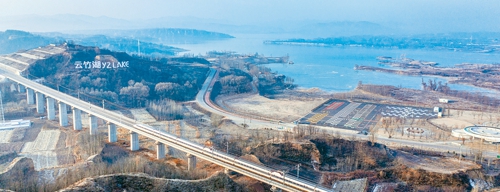 |
|
The Taiyuan-Zhengzhou High-Speed Train passes Yunzhu Lake, a renowned tourist attraction in Yushe county.[Photo provided to China Daily] |
"The current trip to Zhengzhou takes about one hour. I departed Changzhi in the morning and will be back in the afternoon. This can save a great deal of time compared with the single trip of nearly five hours previously."
Residents in the Taihang Mountains are among the happiest with the operation of this high-speed train, as it provides easier connectivity for the landlocked region.
"The high-speed train can bring many more tourists to Wuxiang as travel from Taiyuan takes less than an hour and from Zhengzhou less than two hours," said Wu Binkui, deputy chief of the culture and tourism bureau of the county located in the Taihang Mountains.
Home to the former headquarters of the Eight Route Army, a major military force led by the Communist Party of China who fought the Japanese invaders more than 70 years ago, Wuxiang is an important "red tourism" destination in Shanxi province. Red tourism refers to tours of former revolutionary sites relating to the CPC that combine offerings of patriotic education and sightseeing.
Li Kai, head of staff at the inaugural train, knows the local attractions better than many others. He introduced all the destinations to passengers on the train.
"There are about 50 4A-or-above tourism destinations along the railway, including famous attractions such as Jinci Temple in Taiyuan, residences of Jinshang merchants in Taigu, Yunzhu Lake in Yushe, Eighth Route Army Museum in Wuxiang, Imperial Prime Minister's Residence in Jincheng, Yuntai Mountains in Henan's Jiaozuo city and Shaolin Temple in Zhengzhou," Li Kai told passengers.
Lou Yangsheng, Party secretary of Shanxi province, was also present at the inauguration ceremony.
"Today is a great day as we witnessed the inaugural operation of the Taiyuan-Zhengzhou High-Speed Train, which marks another important passageway to link Shanxi with the rest of the country," Lou said.
The provincial Party chief said special thanks should be given to the workers who built the railway as they overcame great difficulties during its construction.
The total length of tunnels and bridges accounts for 74.8 percent of the railway's mileage, making the line one of the most difficult railway projects in the northern and central parts of China, according to Shao Liangjun, a manager of China Railway 10th Bureau, the construction group building the railway.
"There are a total of 39 tunnels and five are each longer more than 10 km," Shao said.
Despite the difficulties, Shao, who was also on board of the train, said he is "very satisfied with the quality of the project."
He put a cup of water on the windowsill. "The cup stays stable even when the speed changes and the train makes turns," Shao said.
Guo Yanjie contributed to this story.